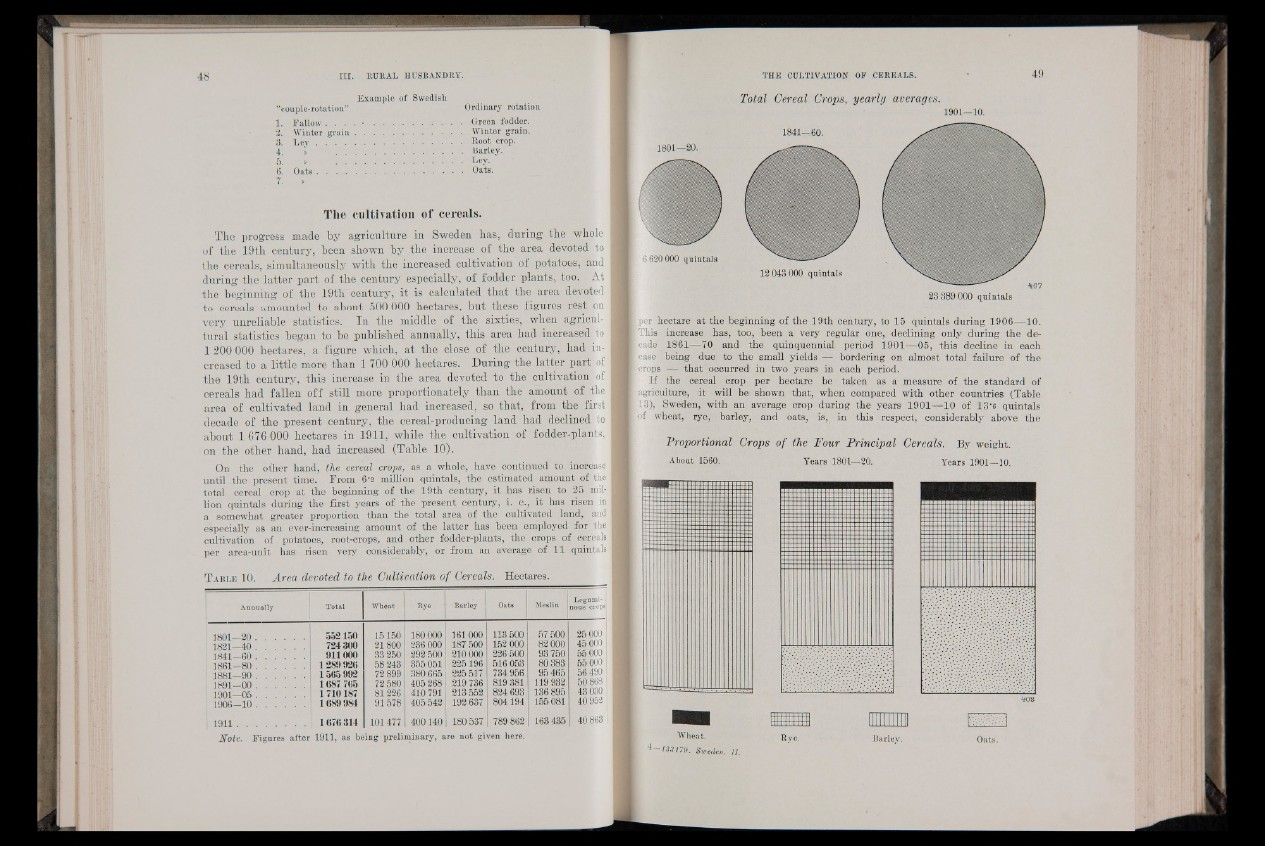
Example of Swedish
’’couple-rotation” Ordinary rotation
1. Fallow ................................... Green fodder.
2. Winter g r a in ............................................_ Winter grain.
L e v ............................................................Root crop.
4. > Barley.
5. > .................................... Ley.
6. Oats ................................Oats.
7. »
The cultivation of cereals.
The progress made by agriculture in Sweden has, during the whole
of the 19th century, been shown by the increase of the area devoted to
the cereals, simultaneously with the increased cultivation of potatoes, and
during the latter part of the century especially, of fodder plants, too. At
the beginning of the 19thT century, it is calculated that the area devoted
to cereals amounted to about 500 000 hectares, but these figures rest on
very unreliable statistics. In the middle of the sixties, when agricultural
statistics began to be published annually, this area had increased to
1 200 000 hectares, a figure which, at the close of the century, had increased
to a little more than 1 700 000 hectares.- During the latter part of
the 19th century, this increase in the area devoted to the cultivation of
cereals had fallen off still more proportionately than the amount oftthe
area of cultivated land in general had increased, so that, from the first
decade of the present century, the cereal-producing land had declined to
about 1 676 000 hectares in 1911, while the cultivation of fodder-plants,
on the other hand, had increased (Table 10).
On the other hand, the cereal crops, as a whole, have '.continued to increase
until the present time. From 6'2 million quintals, the estimated amount of the
total cereal crop at the beginning of the 19th century, it . has risen to 25 million
quintals during the first years of the present, century, i. e., it has risen in
a somewhat greater proportion than the total area of the cultivated land,^and
especially as an ever-increasing amount of the latter has been employed foj the
cultivation of potatoes, root-crops, and other fodder-plants, the crops of Cereals
per area-unit has -, risen very considerably, or from an average of 1 1 quintals
T able 10. Area devoted to the Cultivation of Cereals. Hectares.
Annually Total Wheat Rye Barley Oats Meslin
Leguminous
props
Total Cereal Crops, yearly averages.
1901—10.
I per hectare at the beginning of the 19th century, to 15 quintals during 1906— 10.
This increase has, too, been a very regular one, declining only during the de-
¡cade 1861—70 and the quinquennial period 1901—05, this decline in each
case being due to the small yields — bordering on almost total failure of the
crops — that occurred in two years in each period.
If the cereal crop per hectare be taken as a measure of the standard of
agriculture, it -will be shown that, when compared with other countries (Table
13), Sweden, with an average crop during the years 1901—10 of 13 ‘6 quintals
of wheat, rye, barley, and oats, is, in this respect, considerably above the
Proportional Crops of the Four Principal Cereals. By weight.
About 1560. Years 1801—20. Years 1901—10.
1 1801—20 ................ 552150 15 150 180 000 161000 113 500 57 500 25 000
1821—40 . . . . HBB 724 300 21800 236 000 187 500 152 000 82 000 45 000
1841—60 . . . . . 911000 33 250 292 500 210 000 226 500 93750 55 000
1861—80 . . . . . 1289 926 58 243 355 051 225196 516 053 80 383 55 000
1 1881—90 . . . . I 1565 992 72 899 380 665 225 517 734 956 95 465 56 490
I 1891—00 . . . . ; 1687 765 72 580 405268 219 736 819 381 119 932 50 868
1901—05 . . . . .1 1 710187 ! 81226 410 791 213 552 824 693 136 895 43 030
1 1906—10 . . . . . 1689 984 91578 405 542 192 637 804 194 155 081 40 952
| 1911 .................... ’ | : 1676314 101477 400140 180 537 789 862 163 435 40 863
Note. Figures after 1911, as being preliminary, are not given here. Wheat.
4 —133170. Sweden. II.
Bariev. Oats.
1841—_60.
12 043 000 quintals
23 389 000 quintals
1801—20.
6 620000 quintals